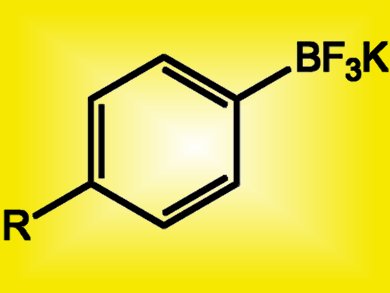In comparison to arylboronic acids, aryltrifluorborates are readily accessible and purified and benefit from a longer shelf life. They represent good alternatives for arylboronic acids in several palladium-catalyzed reactions, and due to recent advances their diversity has expanded.
Mats Larhed and coworkers, Uppsala University, Sweden, exploit this class of protected boronic acids by developing a base-free, microwave-assisted method for the regioselective palladium(II)-catalyzed coupling of aryltrifluoroborates and olefins. While electron deficient n-butyl acrylate is terminally arylated, n-butyl vinyl ether is internally arylated when employing aryltrifluoroborates and aryl N-methyliminodiacetic acid boronates. ESI–MS analysis revealed that the arylboronic acid is present in the reaction mixture suggesting it to be the species that undergoes the transmetallation step. Most likely, the oxidizing agent para-benzoquinone or O2 acts as a hydride acceptor, thereby preserving the oxidation state of palladium(II) throughout the catalytic cycle.
- Oxidative Heck Reactions using Aryltrifluoroborates and Aryl N-Methyliminodiacetic Acid (MIDA) Boronates,
Jonas Sävmarker, Jonas Lindh, Peter Nilsson, Per J. R. Sjöberg, Mats Larhed,
ChemistryOpen 2012, 1(3), 140–146.
DOI: 10.1002/open.201200007
ChemistryOpen – the first society-owned, open-access, chemistry journal – is a journal of ChemPubSoc Europe published by Wiley-VCH.




